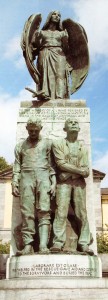Lusitania Peace Memorial
Published in Gems of Architecture, Issue 3 (May/June 2015), Volume 23Since 1968 this sculptural masterpiece has honoured ‘all who perished’ on 7 May 1915. Kerry-born Jerome Connor (1874–1943), after a career in Washington DC, was asked in 1925 to create a design recalling the Lusitania tragedy and promoting a vision of world peace. The memorial’s ‘mourning fishermen’ evoke the grief of the local rescuers, while its ‘angel’, her foot on a sword, embodies the broader appeal for an end to all wars.
In 1925 the Lusitania theme was politically sensitive, with Queenstown renamed Cobh, and its main square, the entry point for international visitors, now Casement Square, reflecting a new national vision. In August 1926, Minister for Home Affairs Kevin O’Higgins rejected a rival design by sculptor Andrew O’Connor, although this was intended for a remote headland site. Jerome Connor’s design, proposed by victims’ families and US politicians, and involving an approach by the US State Department to Ireland’s fledgling Department of External Affairs, proved acceptable, and in March 1927 the Casement Square site was approved by the ministers of external affairs and of local government and public health.
In 1929, after finishing an American memorial to his friend Elbert Hubbard, a Lusitania victim, Connor developed the design, an ‘Angel of Peace’, but that October the Wall Street Crash stopped fund-raising and the project, like the Lusitania itself, needed rescuers. In 1933 art patron and sculptor Mrs Harry Payne Whitney, sister of Lusitania victim Alfred Vanderbilt, offered help. She sought changes, however, and over some months Connor made several further scale models, until a design, including fishermen, was agreed: today’s memorial is the result of this collaboration. In November 1934 Connor returned to Dublin, completed the full-size plasters, carried out the carving and lettering, installed the stonework, and (being also a bronze founder) then cast the fishermen—the first large lost-wax bronzes made in Ireland.
Local traders had seen the memorial as disrupting their business and the Urban District Council, annoyed by the delays, later sought to cancel the project. It would have been complete by 1936 had not the collapse of another project, a figure of ‘Éire’ for Killarney, left Connor with major financial and legal problems. After his death in 1943 his admirers, including Chief Justice Conor Maguire and sculptor Domhnall Ó Murchadha, worked to see the memorial realised. In 1953 the Friends of the National Collections of Ireland erected the fishermen, and in 1965, the Lusitania’s 50th anniversary, Taoiseach Seán Lemass, concerned with American sensibilities, had the Arts Council engage Ó Murchadha to have the angel cast in Italy. The memorial was completed in 1968.
Traditional in style, reflecting Connor’s 1890s training, the work blends well with its classical architectural setting. Despite its troubled history, it is hard to imagine Cobh today without its Lusitania Peace Memorial.
Giollamuire Ó Murchú is an architect and art historian and the author of Jerome Connor: Irish American sculptor 1874–1943 (Dublin, 1993). Series based on the National Inventory of Architectural Heritage’s ‘building of the month’, www.buildingsofireland.ie.

















